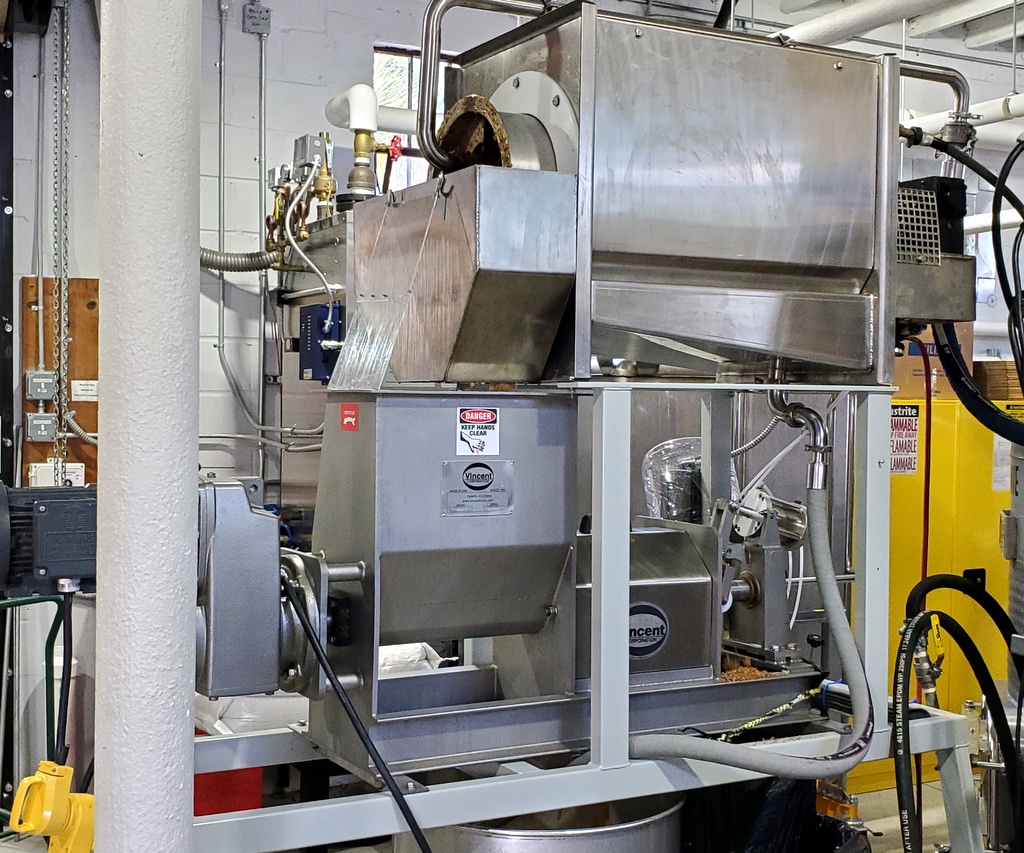APRIL 19, 2022

Craft breweries have been booming for the last decade. Craft distilleries are now making up for lost time. For purposes of this discussion, we should differentiate between spent distillers’ grain and spent brewers’ grain. Barley is the main component of spent brewers’ grain. Tied to the type grain, we have found that mechanical dewatering can take this grain down to around 69% moisture, but that is from a starting moisture of 80% for macros and 75% for craft brewers. Spent distillers’ grains, SDG, is mostly corn, wheat, rye, or other grains and can typically be dewatered to around 60% moisture, but with a starting point of 90% or higher. We have one large brewer and 16 (and growing) distilleries using our screw press.
Large distilleries have long had an issue with disposal of their spent grain. Historically, most macro distillers dewatered and dried their grain. The liquid squeezed out was evaporated to produce a “syrup”. This syrup was both combined with the grain before drying and/or pumped to tanker trucks for feeding to farm animals. DDGS – Dried Distillers’ Grain with Solubles is the term used to describe dried spent grains with the syrup added in. But there are other ways that distilleries dispose of their spent distillers’ grains. Some load the spent grain in its diluted state (6 – 9% solids) into farmers’ tanker trucks. Those farmers form berms in their pastures and allow the grain to thicken before feeding. In extreme cases, some micro distillers send the spent grain down the drain. The municipal fines can be hefty, but illustrate the difficulty in getting rid of these “mill residuals”. The fines are based on the level of solids in the water, the high levels of soluble organics, COD and BOD. Some distilleries are now moving toward a thickening of the grain to 18 – 40% solids (60 – 82% moisture) using rotary drum screens and/or screw presses, skipping the drying step, and saving the fuel costs of operating a dryer. This was the approach most macro brewers took in the 70’s when the price of natural gas spiked.
Most of Vincent’s efforts are targeted toward the smaller distillery. These range from small batch-based pot still operations to regional distilleries running continuous columns in the range of 15 – 25 gpm. Some of these regional distilleries are significant businesses; one of our customers recently sold their distillery for $110 million. We typically go after this market with our CP-4 or CP-6 screw press. For pre-thickening, to improve capture rate and increase the throughput capacity of the presses, we use a rotary drum screen (RDS) produced by Soluble Organic Solutions, (https://www.spentstillage.com/). For the CP-4, flow to the RDS can be as high as 18 gallons per minute. For the CP-6, 40 gallons per minute. For lower flows, a stand-alone press or RDS can be the answer.
Throughput for SDG is highly variable and depends on:
• Type of grain – Wheat works great, corn works well, and rye works.
• Grind on the grain – Fine grinds are more difficult to separate. I’m going to skip the discussion on how the grains should be ground. Suffice it to say there are a lot of different opinions on the impact on yield and flavor.
• Cook time.
• Fermentation time.
and most importantly:
• When the solids are separated out – Again, there are a lot of opinions regarding the impact on flavor, but some distilleries separate after cooking and then ferment “off the grain”, while others leave the grain in and ferment “on the grain”. Throughput on our press is much higher when fermenting off the grain. This process also allows for greater storage capacity during fermentation and increases yields by up to 30% vs. just draining the stillage off through a lautering ton. We have traditionally presented the screw press as a method of separating water from solids to facilitate disposal, but one of our customers, fermenting off the grain, says that both the brix (sugar level) and the yield of the liquid squeezed out by the system produced additional alcohol to the level of over $200,000 per year. He is pretty excited.
Here’s a video of an RDS feeding the Vincent CP-4 screw press at Tarpon Springs Distillery: https://youtu.be/fMUtilrcvf0
The dewatered spent grains are typically given to a farmer for feed or compost. Cows and hogs love the spent grain. At one distillery an amused farmer was telling us that his bull got loose and ate the spent grain till he was caught. The bull had a bleary look in his eyes, from over-eating.
The liquid squeezed from the grains has a high soluble organic load COD and BOD. Chemical treatment is effective and worthwhile for the larger craft distilleries. The combination of chemistry and physical solids separation with the RDS and Vincent screw press can reduce the COD and BOD numbers by as much as 60% vs. doing nothing. Small distilleries typically fly under the radar and send it to municipal wastewater treatment or just put it in an IBC tote for a local farmer to pick up.
ISSUE #341
